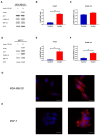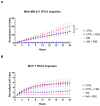Breast Cancer Cell Line-Specific Responses to Insulin: Effects on Proliferation and Migration
- PMID: 40806650
- PMCID: PMC12347025
- DOI: 10.3390/ijms26157523
Breast Cancer Cell Line-Specific Responses to Insulin: Effects on Proliferation and Migration
Abstract
Breast cancer (BC) progression appears to be significantly influenced by the diabetic microenvironment, characterised by hyperglycaemia and hyperinsulinemia, though the exact cellular mechanisms remain partly unclear. This study investigated the effects of exposure to supra-physiological levels of glucose and insulin on two distinct BC cell models: hormone-responsive MCF-7 cells and triple-negative MDA-MB-231 cells. To evaluate the effects triggered by high insulin level in different BC cell subtypes, we analysed the activation status of PI3K/AKT and MAPK pathways, cell proliferation, cell distribution in cell cycle phases and cell migration. High insulin level significantly activates the insulin metabolic pathway via AKT phosphorylation in both cell lines while inducing pro-proliferative stimulus and modulation of cell distribution in cell cycle phases only in the hormone-responsive MCF-7 cell line. On the contrary, high-glucose containing medium alone did not modulate proliferation nor further increased it when combined with high insulin level in both the investigated cell lines. However, following insulin treatment, the MAPK pathway remained unaffected, suggesting that the proliferation effects in the MCF-7 cell line are mediated by AKT activation. This linkage was also demonstrated by AKT phosphorylation blockade, driven by the AKT inhibitor MK-2206, which negated the proliferative stimulus. Interestingly, while MDA-MB-231 cells, following chronic hyperinsulinemia exposure, did not exhibit enhanced proliferation, they displayed a marked increase in migratory behaviour. These findings suggest that chronic hyperinsulinemia, but not hyperglycaemia, exerts subtype-specific effects in BC, highlighting the potential of targeting insulin pathways for therapeutic intervention.
Keywords: breast cancer; hyperglycaemia; hyperinsulinemia; insulin signalling; type 2 diabetes mellitus.
Conflict of interest statement
The authors declare no conflicts of interest. Furthermore, the funders had no role in the design of the study; in the collection, analyses, or interpretation of data; in the writing of the manuscript; or in the decision to publish the results.
Figures






Similar articles
-
Prescription of Controlled Substances: Benefits and Risks.2025 Jul 6. In: StatPearls [Internet]. Treasure Island (FL): StatPearls Publishing; 2025 Jan–. 2025 Jul 6. In: StatPearls [Internet]. Treasure Island (FL): StatPearls Publishing; 2025 Jan–. PMID: 30726003 Free Books & Documents.
-
Systemic treatments for metastatic cutaneous melanoma.Cochrane Database Syst Rev. 2018 Feb 6;2(2):CD011123. doi: 10.1002/14651858.CD011123.pub2. Cochrane Database Syst Rev. 2018. PMID: 29405038 Free PMC article.
-
The Black Book of Psychotropic Dosing and Monitoring.Psychopharmacol Bull. 2024 Jul 8;54(3):8-59. Psychopharmacol Bull. 2024. PMID: 38993656 Free PMC article. Review.
-
A natural flavagline derivative A2073 inhibits the proliferation of erythroleukemia cells by targeting the MAPK, PI3K, NF-κB, and cell cycle pathways.Bioorg Chem. 2025 Aug;163:108612. doi: 10.1016/j.bioorg.2025.108612. Epub 2025 May 24. Bioorg Chem. 2025. PMID: 40460610
-
Type 1 Diabetes: A Guide to Autoimmune Mechanisms for Clinicians.Diabetes Obes Metab. 2025 Aug;27 Suppl 6(Suppl 6):40-56. doi: 10.1111/dom.16460. Epub 2025 May 15. Diabetes Obes Metab. 2025. PMID: 40375390 Free PMC article. Review.
References
-
- Magliano D.J., Boyko E.J., IDF Diabetes Atlas 10th edition scientific committee . IDF Diabetes Atlas. International Diabetes Federation; Brussels, Belgium: 2021.
MeSH terms
Substances
Grants and funding
LinkOut - more resources
Full Text Sources
Miscellaneous

